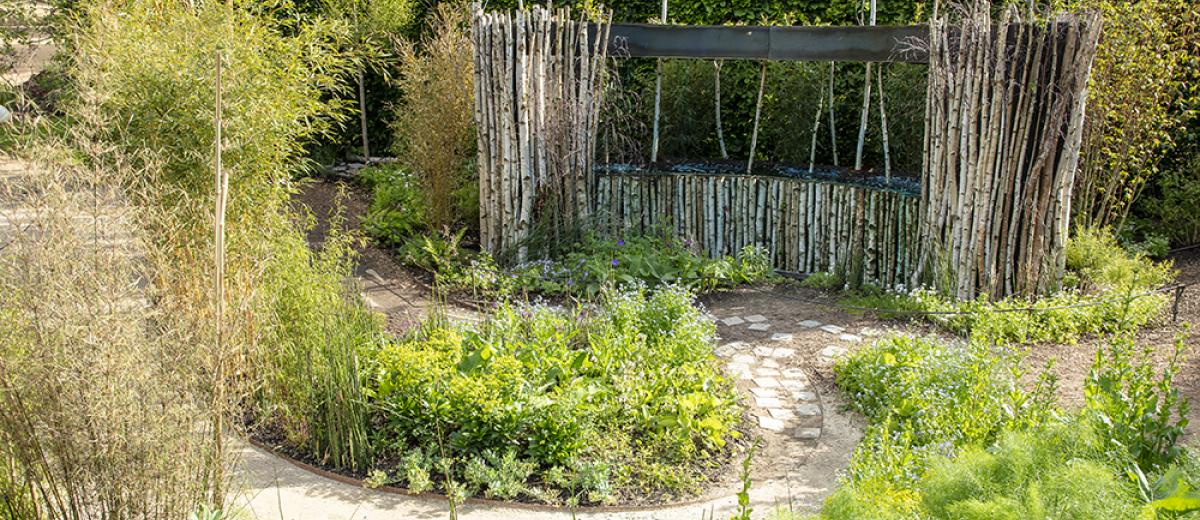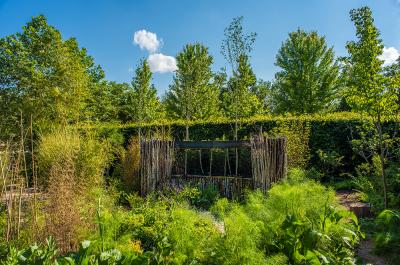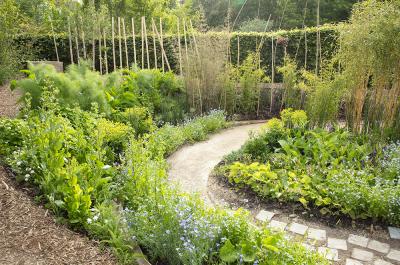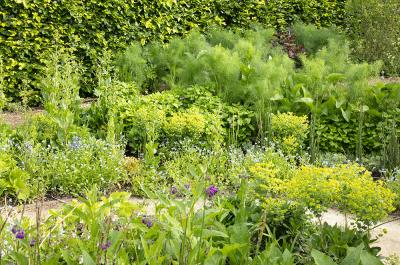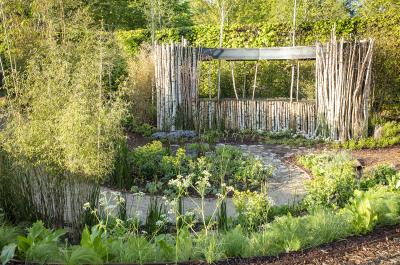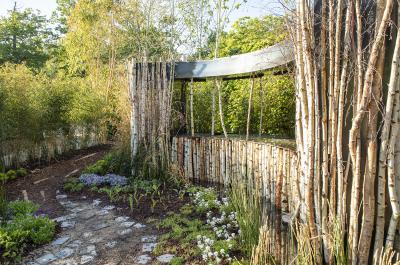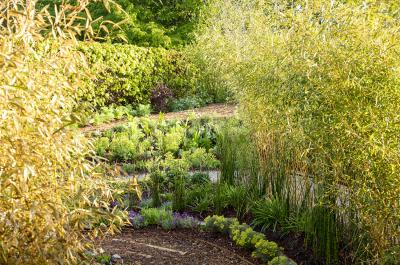Here, mankind has taken inspiration from behaviour witnessed in nature to redefine his individual and collective values. The complexity of the connections between the various plants can be surprising for us as humans, in constant search for revival in light of the various crises that our society faces.
In this garden, the biomimicry trend is reversed: what happens if we give back to the ecosystem, instead of consuming, using and controlling nature? At the centre of the garden, there’s a spectacular fountain made from birch wood, providing freshness and symbolising harmony between living beings. The water flows around the garden through bamboo sticks cut in half, according to an ancient Chinese irrigation technique used in mountainous territory. Visitors are guided through the garden by passages set out by bamboo and horsetail screens, gradually revealing the flowerbeds opposite the central piece, the fountain in shades of blue. The plant-life becomes more and more abundant, until it resembles that of a food forest. From the covering on the ground, to the fruit trees and the tree canopies, the selection of plant-life here is based on companion planting and the agroforestry approach. The association of plant species chosen come together in harmony, helping each other flourish. They protect and strengthen each other, just like the yin and yang in Chinese philosophy.
This garden is the solution for the vital need of contact with nature. In the midst of these living beings, mankind will find a revitalising place.
DESIGNERS
Élodie COTTAR and Xinye TONG, state-registered landscapers und Nassera AMIOUR, urban planner
FRANCE / CHINA
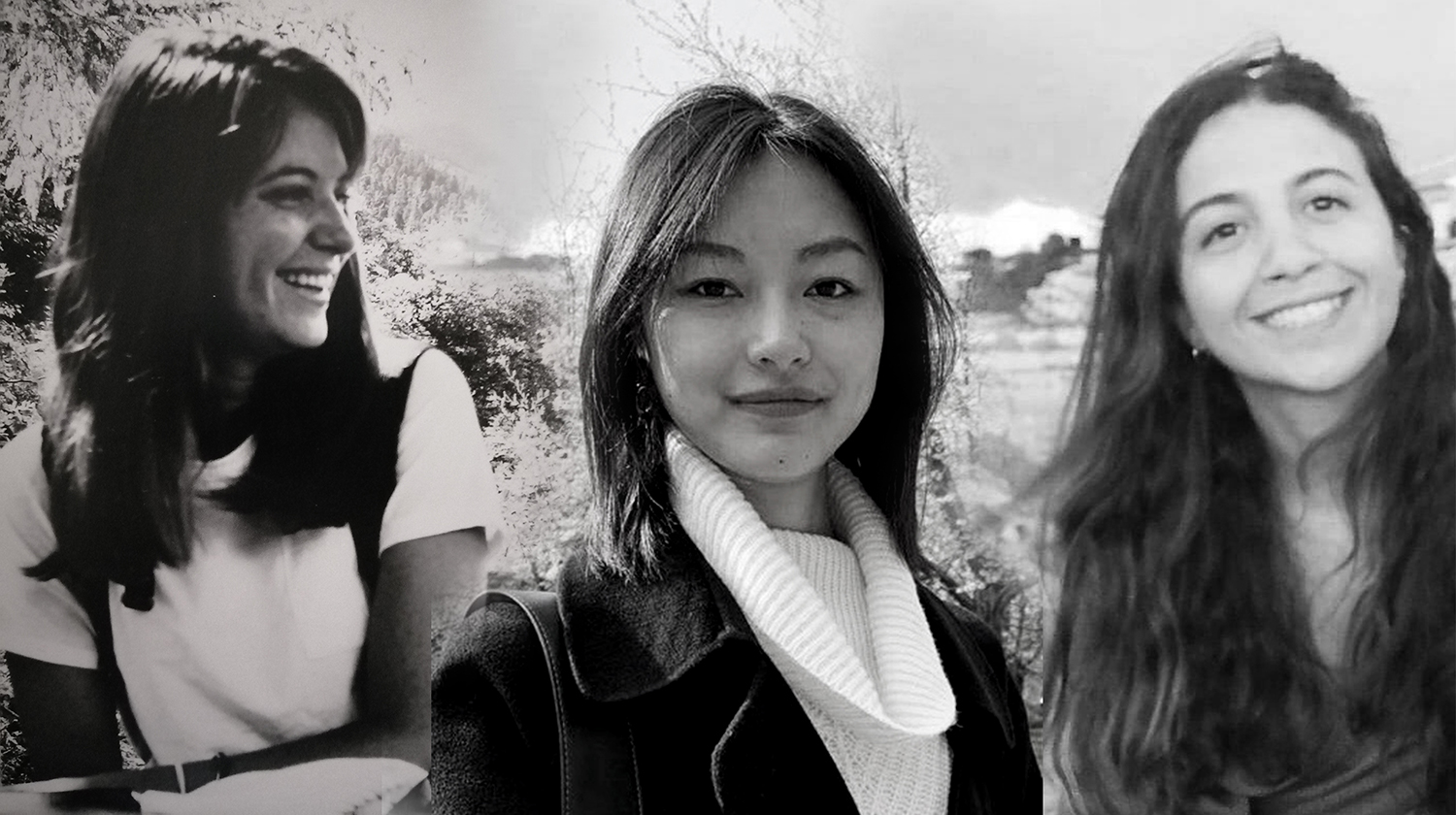
Elodie Cottar
“I have always been passionate about the arts and staging, and throughout my career I’ve explored various paths linked to creation, including fashion design, spatial design and literary, visual and performing arts, before finally bringing them all together and focusing on landscape design. Thanks to this experience in so many fields, I enjoy combining the arts to consider and design the landscape as a multi-faceted unit which we enter as if we were on stage. After three years working for the Development and Landscape department for the city council of Paris, then two years with the Conseil d’Architecture d’Urbanisme et de l’Environnement (Council for Architecture, Urban Planning and Environment) in Paris), I learned a lot about the technicality of landscapes and implementing public awareness campaigns for these issues. Today, I have decided to develop my career based on my studies at the École Nationale Supérieure de Paysage in Versailles, on a self-employed basis. I have developed my own personal approach, based on the ability of blind people to feel and interact with the landscape. And to follow on from that, I consider how the landscape can interact with people with disabilities or behavioural issues. To develop this form of art therapy, I would now like to set up these workshops in the form of urban walking tours, participatory projects and workshops whereby 'artistic/therapeutic' gardens are designed together with participants. Through this experimental approach, subject to the varying senses and the way in which people express themselves, I am always looking to create and renew my work and I keep this in mind when working on other landscape projects, whether it involves restoring and creating gardens, or creating scenographic installations.”
Xinye Tong
"I come from Guiyang, a town in the mountainous region of south-west China, and I grew up in a region with well-preserved nature and traditions. While studying landscape architecture at Beijing University of Agriculture from 2007 to 2011, I learned about different disciplines related to landscape design, including the art of traditional Chinese gardens, botany, designing public spaces and the art of landscape projects. I did a year’s work experience in 2012 in the university’s public art studio, and I learned a lot about the arts during that time. I found French art and culture fascinating and so I decided to carry on my studies in France. I did a Master’s degree in urban landscape at the University of Angers and Agrocampus Ouest in 2013, and this gave me a completely different vision of urban development compared to what I had seen in China. I then studied for 4 years at the Ecole Nationale Supérieure du Paysage in Versailles and I became an accredited landscaper in 2018. After my studies in Versailles, I went back to my home province of Guizhou to get my end of studies certification. This time back in my home region after years of studying in Beijing and France helped me think about my own personal approach as a multi-cultural landscaper and how I wanted to work. Since 2018, I have been working as a landscaper for Florence Mercier Paysagiste in Paris. My role within this cosmopolitan team is to work on international projects in both France and China, adopting a multi-disciplinary and multi-cultural approach that I try to bring to all my projects. The way I work today as a landscaper-designer is about bringing the traditional art of gardening and Chinese culture alive, while designing with a contemporary approach to spatial and landscape creation."
Nassera Amiour
“I was born in Lorraine and I am a qualified urban planner. For my urban projects, I make sure that there is a dialogue with the locals and that they can participate if they so wish, which is how I managed to achieve an approach that is adapted to the land. I worked on the notion of public space, a place for spontaneous encounters and I studied the accessibility of this in my research as a student. At the moment, I am developing various tools (photos, videos) that will be used to showcase the local area and tell its story. I like being able to work in different ways and across varied disciplines. This is how I came to work with Elodie Cottar and Xinye Tong. Following my professional experience designing school playgrounds, I wanted to make a career out of scenography and so since January 2020, I have been studying this field at the École Nationale Supérieure d’Architecture in Paris-Belleville. This experience also led me to consider the relationship nature has with the city and with society in general. The aspect of my work that deals with the development of scenography design also includes social reflection, and this has guided my experimental approach.”
